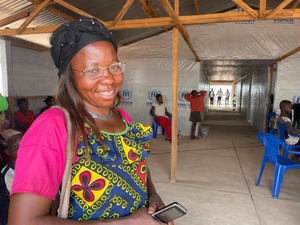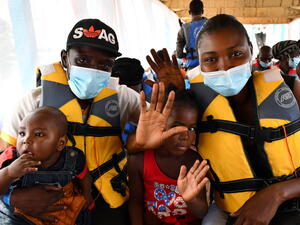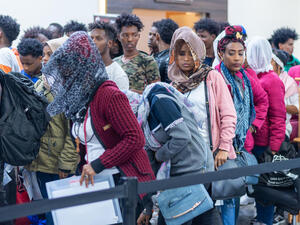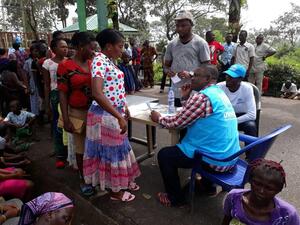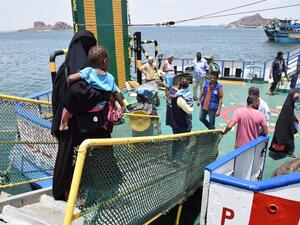Organised returns to Angola reach 35,000, UNHCR ups pace before rains
Organised returns to Angola reach 35,000, UNHCR ups pace before rains

Returnees at a transit centre in Luau, eastern Angola.
LUANDA, Angola, Oct 9 (UNHCR) - With the rainy season just around the corner, the UN refugee agency is expanding its voluntary repatriation programme for Angolan refugees that has reached the 35,000 mark.
Around 15,000 Angolans have returned from Zambia, mainly from Meheba camp near the border with Angola. On Saturday, the first convoy carrying 505 Angolans set out from Mayukwayukwa camp in western Zambia for the four-day trip over 2,000 km to Cazombo in the Angolan frontier province of Moxico. It is the second camp in Zambia where UNHCR is organising return convoys.
In addition, some 17,000 Angolan refugees have gone home from camps in the Democratic Republic of the Congo (DRC) and 3,000 from Namibia since the agency organised returns in June. UNHCR plans to help return 220,000 Angolan refugees under a phased programme over two years.
Hundreds of thousands of uprooted Angolans have returned home since a peace agreement took hold early this year, ending three decades of civil strife. But because most areas in Angola do not have the basic infrastructure to make returns meaningful, UNHCR has decided to organise returns to areas with the capacity to receive the refugees in one of the world's most heavily-mined countries.
Mayukwayukwa's residents include an estimated 7,000 refugees originally from Lumbala N'Guimbo, a commune outside Cazombo. Of this number, 2,000 are set to return before the rainy season begins in late October. UNHCR is working with the Mine Assessment Group to open new areas around this town. The agency and Angolan authorities have also agreed to reopen a land route to the Zambia border. Work has started on four bridges in Lumbala N'Guimbo. The possibility of an airlift is also being discussed in Zambia.
Because hundreds of Angolan refugees could not wait and have returned spontaneously, UNHCR has decided to organise convoys from Mayukwayukwa.
"While UNHCR appreciates the strong desire of the refugees to return home, the repatriation exercise has to be conducted in a systematic and phased manner to ensure that the refugees return home in dignity and safety, and in accordance with the absorption capacity in Angola," said UNHCR's Kelvin Shimo.
Against all odds, UNHCR is continuing efforts to open up new districts in Angola for returns, ensuring that there is water, sanitation, schools, medical services and shelters. In Moxico province - the destination for a majority of refugees and one of the most inaccessible - the agency is developing the more remote districts near the border. Five out of 20 communes in the province have been opened for repatriation from Zambia and the DRC.
In Zaire province in the north, six of 10 communes are now open for return, and four out of five communes in Cuando Cubango in the south have been prepared for Angolans in Namibia. Last week, the first convoy of about 120 refugees arrived in Calai, near the Namibian border. Five more convoys are expected to follow, carrying between 500 and 900 refugees. An additional 2,000 to 3,000 refugees will return to Cuangar, near Calai.
Countrywide, up to two-thirds of the returned families have now been able to reach their final destinations in Angola. The rest are still awaiting onward transportation at reception or transit centres. There, they get landmine-awareness training, HIV/AIDS information, and medical assistance where needed. They also receive a reintegration kit of food rations, a construction kit to rebuild homes and basic household supplies. Once in their villages, they receive agricultural tools and seeds from the Food and Agriculture Organisation.
UNHCR has also assisted 17,000 spontaneous returnees to Angola - comprising 50 percent of refugees going home on their own in 2003 - with the same package received by those who joined its convoys.


